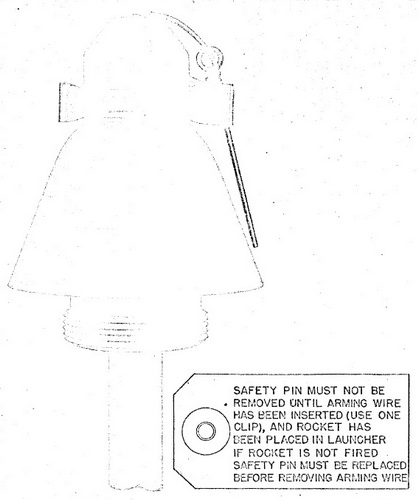|
|
| Fuzes for Rockets and Projector Charge |
| Chapter 6 |
| NOSE FUZES FOR 7.2-INCH DEMOLITION ROCKETS |
| Section B - Nose Fuze Mk 155 Mod 0 (Setback and Air Arming, Impact Firing) |
| 1. General Data |
|
Used in: 3.5-inch Rocket Head Mk 6 Mod 0 (Smoke) |
|
Overall dimensions and weight of fuze: |
|
Length |
17.44 inches |
|
Diameter (maximum) |
2.99 inches |
|
Body threads |
1.700 inches – 14 NS - 1 |
|
Weight |
3.2 lbs. approx. |
|
Applicable specification: OS 3578 |
|
General arrangement drawing: 423845 |
|
Sketch list of drawing & specs: 109406 |
|
Explosive components: |
|
A sensitive stab type compound Detonator Mk 23 (lead azide primer mixture, lead azide and tetryl) located in the shutter between the firing pin guide and lead-in discs. |
|
A lead-in assembly charge (tetryl) located in the lead-in disc between the shutter and burster tube. |
|
A burster tube charge (approximately 65 grams tetryl) located in the burster tube. |
| 2. Description |
|
General. The Fuze Mk 155 differs from the Fuze Mk 149 only in that it is provided with a burster tube assembly instead of a magazine. The burster tube has a 0.630-inch diameter and is 14.06 inches long. |
|
Figure 28 – Nose Fuze Mk 155, External View,
Full Size (approximately) except for Burster Tube |
 |
|
Use. The fuze is used in the 3.5-inch Fin Stabilized Aircraft Smoke Rockets (Complete Round) Mk 3 Mod 0 and Mod 1 (See OP 1415). |
|
Functioning mechanism. The Fuze Mk 155 is exactly the same as the Fuze Mk 149 except a tetryl filled burster replaces the tetryl filler booster at the base end. |
|
Figure 29 – Nose Fuze Mk 155 Mod 0, Cross Section View, Unarmed Position |
|
|
|
Figure 30 – Nose Fuze Mk 155 Mod 0, Cross Section View, Armed Position |
|
|
| 3. Functioning |
|
Arming. Same as Fuze Mk 149 Mod 0. |
|
Firing. Same as Fuze Mk 149 Mod 0. |
|
Acceptance test data. Completely loaded fuzes from each lot are installed in "FS" Smoke loaded 3.5-inch Rocket Heads Mk 6 Mod 0, using a 3.25-inch Rocket Motor Mk 7, an arming wire and Fahnestock clip, and fired from a land launcher at 15 degree quadrant angle for water impact. The temperature of the rocket propellant must be at least 60 de-grees Fahrenheit. Acceptance is based on a cumulative test plan designed to accept (95% of the time) lots in which 98% of the fuzes function satisfactorily. Lots poorer than 98% will be subject to rejection with lots 91% effective being rejected 90% of the time. Any premature causes rejection of the lot. Eight completely loaded fuzes selected from the combined samples of five production lots are assembled in smoke loaded heads and fired from aircraft for water or ground impact. The prescribed service arming wire arran-gement is used. Half the sample are fired for ground impact. Satisfactory performance is considered to be the high order functioning of at least seven of the eight fuzes. Any pre-mature causes rejection. |
| 4. Safety Features |
|
Same as Fuze Mk 149 Mod 0. |
| 5. Disposal and Servicing (Maintenance) |
|
Same as Fuze Mk 149 Mod 0. |
| 6. Installation Instructions |
|
The assembly of the Fuze Mk 155 into the head differs from the assembly of the Fuze Mk 149 into the head only in that the burster tube of the Fuze Mk 155 fits into a burster well and no auxiliary booster is used. |
| 7. Packing and Marking. |
|
Packing. Fuzes Mk 155 are packed in individual, sealed, metal containers. Twelve fuzes are packed in a wood box 18 inches by 12.8 inches by 23 inches which represents 3.1 cu. ft. and a total weight of 77 pounds. |
|
Marking. The fuze is marked to show the letters NF, the mark, mod, lot number, ma-nufacturer's initials, date of loading, symbol of loading plant, and the anchor stamp. |